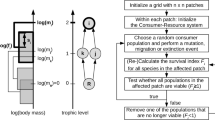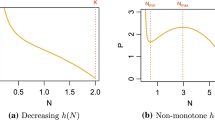Summary
Ecosystems distributed in space have an effective size, reflecting both their absolute size (extent) and their fine-scale physical structure (viscosity). In this paper, a general mathematical model of a predator-prey interaction is presented via the phase-plane graphs of Rosenzweig and MacArthur (1963) to show one reason why ecosystems of larger effective size should persist longer than smaller ones: oscillations of population densities tend to be displaced farther from extinction thresholds—even in spatially homogeneous systems. Experimental results obtained by Gause and Luckinbill with protozoa and Huffaker with mites are interpreted in this context.
Similar content being viewed by others
References
Armstrong, R.A.: The effects of predator functional response and prey productivity on predator-prey stability: a graphical approach. Ecology 57, 609–612 (1976)
Beddington, J.R., Free, C.A., Lawton, J.H.: Concepts of stability and resilience in predator-prey models. J. Anim. Ecol. 45, 791–816 (1976)
den Boer, P.J.: Spreading of risk and stabilization of animal numbers. Acta. Biotheoret. 18, 165–194 (1968)
Burnett, T.: An acarine predator-prey population infesting stored products. Can. J. Zool. 42 655–673 (1964)
Caswell, H.: Predator-mediated coexistence: a non-equilibrium model. Am. Nat. 112, 127–154 (1978)
Crow, M.E.: Increasing complexity: how to lose your marbles and increase stability. In preparation
Crowley, P.H.: Spatial heterogeneity and the stability of a predator-prey link. Ph. D. thesis, Michigan State Univ. (1975)
Crowley, P.H.: Spatially destributed stochasticity and the constancy of ecosystems. Bull. Math. Biol. 39, 157–166 (1977)
Crowley, P.H.: How dispersal stabilizes multicellular ecosystems. In preparation a
Crowley, P.H.: Spatial texture and the stability of a predator-prey link. In preparation b
Crowley, P.H.: Predator-mediated coexistence: an equilibrium interpretation. In preparation c
Flanders, S.E., Badgley, M.E.: Prey-predator interactions in self-balanced laboratory populations. Hilgardia 35, 145–183 (1963)
Fransz, H.G.: Simulation of predator-prey relationships in an acarine system. Pestic. Sci. 5, 305–317 (1974)
Free, C.A., Beddington, J.R., Lawton, J.H.: On the adequacy of simple models of mutual interference for parasitism and predation. J. Anim. Ecol. 46, 543–554 (1977)
Gause, G.F.: The struggle for existence. Baltimore: Williams and Wilkins 1934
Gilpin, M.E.: Enriched predator-prey systems: Theoretical stability. Sciences 177, 902–904 (1972)
Griffiths, K.J.: The importance of coincidence in the functional and numerical responses of two parasites of the European Pine Sawfly, Neodiprion sertifer. Can. Entomol. 101, 673–713 (1969)
Griffiths, K.J., Holling, C.S.: A competition submodel for parasites and predators. Can. Entomol. 101, 785–818 (1969)
Hassell, M.P., Lawton, J.H., and Beddington, J.R.: The components of arthropod predation. I. The prey death rate. J. Anim. Ecol. 45, 135–164 (1976)
Hassell, M.P., May, R.M.: Stability in host-parasite modes. J. Anim. Ecol. 42, 693–726 (1973)
Holling, C.S.: The functional response of predators to prey density and its role in mimicry and population regulation. Mem. Entomol. Soc. Canada (45) (1965)
Holling, C.S.: The functional response of invertebrate predators to prey density. Mem. Entomol. Soc. Canada (48) (1966)
Horn, H.S., MacArthur, R.H.: On competition in a diverse and patchy environment. Ecology 53, 749–752 (1972)
Huffaker, C.B.: Experimental studies on predation: Dispersion factors and predator-prey oscillations. Hilgardia 27, 343–383 (1958)
Huffaker, C.B., Shea, K.P., Herman, S.G., Experimental studies on predation, complex dispersion and levels of food in an acarine predator-prey interaction. Hilgardia 34, 305–329 (1963)
IBM Corp.: System 360 Continuous System Modeling Program user's manual, GH-2000637. White Plains, New York: IBM 1972
Kohn, A.J., Leviten, P.J.: Effect of habitat complexity on population density and species richness in tropical intertidal predatory gastropod assemblages. Oecologia (Berl.) 25, 199–210 (1976)
Leslie, P.H., Gower, J.C.: The properties of a stochastic model for the predator-prey type of interaction between two species. Biometrica 47, 219–234 (1960)
Luckinbill, L.S.: Coexistence in laboratory populations of Paramecium aurelia and its predator Didinium nasutum. Ecology 54, 1320–1327 (1973)
Luckinbill, L.S.: The effects of space and enrichment on a predator-prey system. Ecology 55, 1142–1147 (1974)
MacArthur, R.H., Pianka, E.: On optimal use of a patchy environment. Am. Nat. 100, 603–609 (1966)
Maly, E.J.: A laboratory study of the interaction between the predatory rotifer Asplanchna and Paramecium. Ecology 50, 59–73 (1969)
Maly, E.J.: Interations among the predatory rotifer Asplanchna and two prey, Paramecium and Euglena. Ecology 56, 346–358 (1975)
May, R.M.: Complexity and stability in model ecosystems. Princeton: Univ. Press 1973
Maynard Smith, J.: Models in ecology. Cambridge: Univ. Press 1974
Menge, B.A., Sutherland, J.P.: Species diversity gradients: Synthesis of the roles of predation, competition, and temporal heterogeneity. Am. Nat. 110, 351–369 (1976)
Murdoch, W.W., Oaten, A.: Predation and population stability. Adv. Ecol. Res. 9, 1–130 (1975)
Nicholson, A.J.: The balance of natural animal populations. J. Anim. Ecol. 2, 132–178 (1933)
Pimentel, D., Nagel, W.P., Madden, J.L.: Space-time structure of the environment and the survival of parasite-host systems. Am. Nat. 97, 141–166 (1963)
Rosen, R.R.: Dynamical system theory in biology, Vol. I. New York: Wiley 1970
Rosenzweig, M.L.: Why the prey curve has a hump. Am. Nat. 103, 81–87 (1969)
Rosenzweig, M.L.: Paradox of enrichment: Destabilization of exploitation ecosystems in ecological time. Science 171, 385–387 (1971)
Rosenzweig, M.L.: Enriched predator-prey systems: Theoretical stability. Science 177, 904 (1972)
Rosenzweig, M.L., MacArthur, R.H.: Graphical representation and stability conditions of predator-prey interactions. Am. Nat. 97, 209–223 (1963)
Salt, G.W.: Predator and prey densities as controls of the rate of capture by the predator Didinium nasutum. Ecology 55, 434–439 (1974)
Smith, F.E.: Spatial heterogeneity, stability, and diversity in ecosystems. In: Growth by intussusception: Ecological essays in honor of G. Evelyn Hutchinson (E.S. Deevey, ed.), pp. 309–335. New Haven: Conn. Acad. Arts Sci. 1972
Speight, M.R., Lawton, J.H.: The influence of weed-cover on the mortality imposed on artificial prey by predatory ground beetles in cereal fields. Oecologia (Berl.) 23, 211–223 (1976)
Tanner, J.T.: The stability and the intrinsic growth rates of prey and predator populations. Ecology 56, 855–867 (1975)
Udovic, J.D., Pimentel, D., Nafus, D.: The interaction between spatial heterogeneity and genetic feedback in laboratory predator-prey systems. Oecologia (Berl.) 25, 23–34 (1976)
Ware, D.M.: Predation by rainbow trout (Salmo gairderi): The influence of hunger, prey density, and prey size. J. Fisheries Res. Board Can. 29, 1193–1201 (1972)
White, E.G., Huffaker, C.B.: Regulatory processes and population cyclicity in laboratory populations of Anagasta kuhniella (Zelber) (Lepidoptera: Phycitidae). II. Parasitism, Predation, competition, and protective cover. Res. Popul. Ecol. 11, 150–185 (1969)
Author information
Authors and Affiliations
Rights and permissions
About this article
Cite this article
Crowley, P.H. Effective size and the persistence of ecosystems. Oecologia 35, 185–195 (1978). https://doi.org/10.1007/BF00344731
Received:
Issue Date:
DOI: https://doi.org/10.1007/BF00344731




